Scientific Session
Psychoradiology
Session Topic: Psychoradiology
Session Sub-Topic: Update on Schizophrenia
Oral
Neuro
| Wednesday Parallel 2 Live Q&A | Wednesday, 12 August 2020, 14:30 - 15:15 UTC | Moderators: John Port |
Session Number: O-06
0798.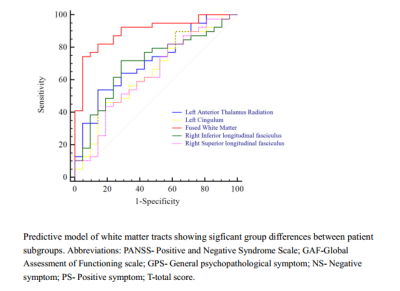 |
Pretreatment white matter integrity predicts one-year clinical outcome in first episode schizophrenia
Jiaxin Zeng1, Wenjing Zhang1, Gui Fu2, Lu Liu3, Biqiu Tang1, Na Hu1, Yuan Xiao1, Qiyong Gong1, and Su Lui1
1West China Hospital of Sichuan University, Chengdu, China, 2Sun Yat-sen University Cancer Center, Guangzhou, China, 3The First People’s Hospital of Ziyang, Ziyang, China
The unrevealing neuropathology underlying different clinical outcome has blocked effective treatment of schizophrenia. In this study, by prospectively recruited patients at baseline and followed them up for one-year, we have revealed the promising role of disrupted white matter integrity in discriminating good outcome from poor outcome schizophrenia. Further, the baseline white matter integrity in left anterior thalamus radiation is positively correlative with reduction of clinical ratings after one-year in all the patients. These findings indicated the underlying substrates in patients with different clinical outcomes and can serve as the potential imaging characteristic in differentiating these patients before initiating of antipsychotics.
|
|
0799.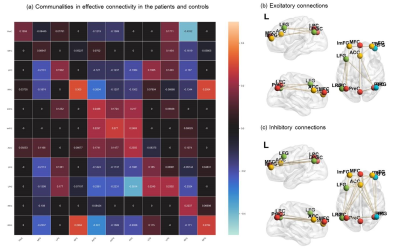 |
Triple Network Hypothesis-related disrupted connections are associated with positive and negative symptoms in first-episode schizophrenia
Yibin Xi1, Fan Guo1, Longbiao Cui1, Xiaocheng Wei2, Baojuan Li1, and Hong Yin1
1The Fourth Military Medical University,Xi’an,China, Xi’an, China, 2MR Research China,GE Healthcare, Beijing, China
Schizophrenia is one complex mental disorder. However the dysregulated cross-network interactions among the SN, CEN and DMN and how they contributed to different symptoms is still not clear. By analyzing network interactions among the SN, CEN and DMN in patients and controls using DCM,as well as the relationship between network dynamics and clinical symptoms, our study provides strong evidence for the dysregulation among SN, CEN and DMN in a triple-network perspective in first-episode schizophrenia. We further proved that the connection between DMN and CEN could be clinically-relevant neurobiological signature of schizophrenia symptoms.
|
|
0800.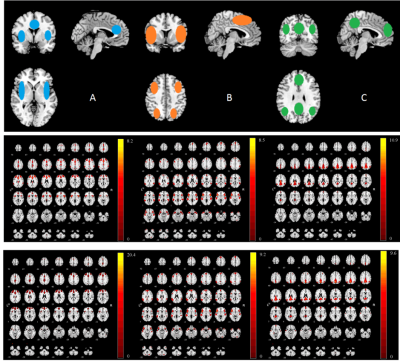 |
A Triple Network Connectivity Study in patients with first episode schizophrenia
Hui Zhang1,2, Pui Wai Chiu1,3, Simon S.Y. Lui4,5, Karen S.Y. Hung4, Raymond C.K. Chan5,6,7, Queenie Chan8, P.C. Sham3,7, Eric F.C. Cheung4, and Henry Ka Fung Mak1,2,3
1Department of Diagnostic Radiology, The University of Hong Kong, Hong Kong, Hong Kong, 2Alzheimer's Disease Research Network, Hong Kong, Hong Kong, 3State Key Laboratory of Brain and Cognitive Sciences, Hong Kong, Hong Kong, 4Castle Peak Hospital, Hong Kong, Hong Kong, 5Neuropsychology and Applied Cognitive Neuroscience Laboratory, CAS Key Laboratory of Mental Health, Institute of Psychology, Chinese Academy of Sciences, Beijing, China, 6Department of Psychology, University of Chinese Academy of Sciences, Beijing, China, 7Department of Psychiatry, The University of Hong Kong, Hong Kong, Hong Kong, 8Philips Healthcare, Hong Kong, Hong Kong
To investigate the major psychopathology of first-episode schizophrenia (SCZ), the triple network model consisting of central executive network (CEN), salience network (SN) and default mode network (DMN) was employed. Group-level independent component analysis and group comparison between schizophrenia patients and healthy subjects within networks were applied. In the results, the SCZ group presented significant hyperconnectivity in bilateral insula within SN and hypoconnectivity in occipital lobe and medial prefrontal cortex within DMN. In addition to that, connectivity in bilateral insula within SN showed significant correlation with PANSS scores.
|
|
0801.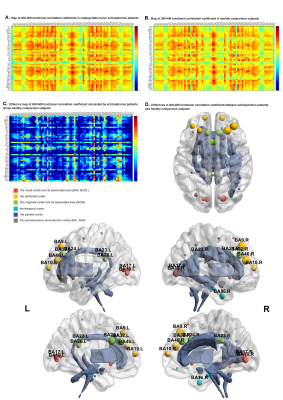 |
Altered functional synchrony between grey and white matter as a novel indicator of brain system dysconnectvity in schizophrenia
Naici Liu1, Wenjing Zhang1, Chengmin Yang1, Jiaxin Zeng1, Rebekka Lencer2, and Su Lui1
Video Permission Withheld
1Sichuan University, Chengdu, China, 2University of Münster, Münster, Germany
Previous studies of white matter (WM) had been limited to structural assessment. In this study, by utilizing resting-state fMRI, the BOLD signals in WM and its functional correlations with BOLD signals in grey matter (GM) were assessed between antipsychotic-naive schizophrenia patients and healthy comparisons. The functional correlation coefficient defined as GM-WM functional synchrony were found widespread altered in patients, especially in WM connecting hemispheres, fronto-temporal, cortico-subcortical regions, and in prefrontal, cingulate, visual, temporal cortex. Additionally, age and illness-duration related alternations in functional synchrony shared the same trend. These findings described schizophrenia as a progressive disorder which was characterized by dysconnectivity.
|
|
0802.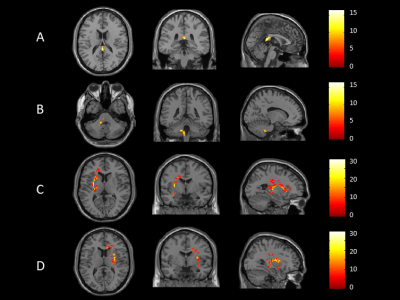 |
Altered resting-state functional activity characterizes white matter function in schizophrenia patients with long-term illness courses
Chengmin Yang1, Wenjing Zhang1, Naici Liu1, Li Yao1, Jiaxin Zeng1, and Su Lui1
1Sichuan University, Chengdu, China
Increasing evidence has suggested white matter (WM) as well raised functional activity in brain and its functional information could be detected by resting-state functional MRI (rs-fMRI). Our study provided new insight into WM functional alterations over the long-term course of schizophrenia with and without the potential effects of antipsychotic medication. Functional changes in the splenium of the corpus callosum (SCC) were found in both treated and untreated patients, which may represent core WM functional changes in schizophrenia.
|
|
| 0803. | Volumetric Alterations in Treated and Never Treated Long-Term ill Schizophrenia Patients
Chandan Shah1, Youjin Zhao1, Na Hu1, Yuan Xiao1, Wenjing Zhang1, Jiaxin Zeng1, and Lui Su1
1Radiology, Sichuan University, Chengdu, China
This project aims at determining specific thalamic nuclei changes in schizophrenia patients with long term illness without the confounding effects of antipsychotics as well as to determine the individual thalamic changes after long term antipsychotics.
|
|
 |
0804.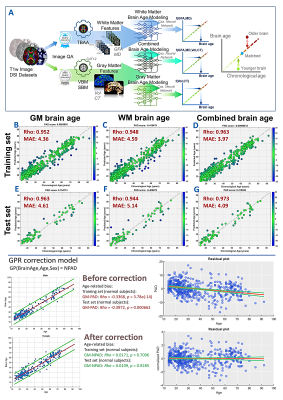 |
Multiple Brain Age Metrics Reveal Premature Brain Aging Network and Association with Clinical Factors in Schizophrenia
Chang-Le Chen1, Li-Ying Yang1, Yu-Hung Tung2, Yung-Chin Hsu3, Chih‐Min Liu4, Tzung‐Jeng Hwang4, Hai‐Gwo Hwu4, and Wen-Yih Isaac Tseng1,5
1Institute of Medical Device and Imaging, College of Medicine, National Taiwan University, Taipei, Taiwan, 2Department of Medicine, College of Medicine, National Taiwan University, Taipei, Taiwan, 3AcroViz Technology Inc., Taipei, Taiwan, 4Department of Psychiatry, National Taiwan University Hospital, Taipei, Taiwan, 5Molecular Imaging Center, National Taiwan University, Taipei, Taiwan
It is unclear how brain regions contribute to the premature aging in schizophrenia and whether different brain age metrics would reveal distinct clinical relevance. Therefore, we developed multiple bias-free brain age metrics based on volumetric and microstructural information to quantify the brain aging of patients with schizophrenia. The results showed that the cortical areas and fiber tracts located in the prefrontal, temporal, and limbic regions manifested dominantly to the premature brain aging compared to the other areas. Also, white matter brain age showed the significant correlation with age of onset, medication dose, and negative symptom, manifesting better clinical sensitivity.
|
0805.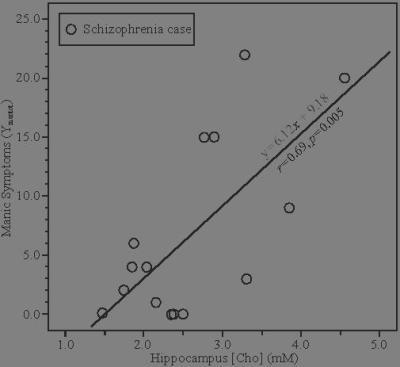 |
Hippocampal Metabolic MR Spectroscopic Imaging Associations with Psychotic and Manic Symptoms in Patients with Schizophrenia
Eyal Lotan1, Dolores Malaspina2, Henry Rusinek1, and Oded Gonen1
Video Permission Withheld
1NYU Langone Medical Center, New York, NY, United States, 2Icahn School of Medicine at Mount Sinai, New York, NY, United States
Previous proton MR spectroscopic imaging of the hippocampus distinguished schizophrenia cases from controls by elevated creatine [Cr] and more variable N-acetylaspartate [NAA] and choline [Cho] concentrations. Here we examine these metabolite’s concentrations in 15 cases against their research diagnostic interviews and symptom ratings. Despite modest cohort size we find: (a) elevated [Cho] predicts psychotic; and (b) manic symptoms severity; and (c) lower [NAA] trended with negative symptoms. These findings suggest that microgliosis and demyelination, reflected by reduced [NAA] and elevated [Cho], may be related to active psychotic and manic symptoms, potentially benefiting precision medicine in selection and monitoring schizophrenia treatment.
|
|
0806.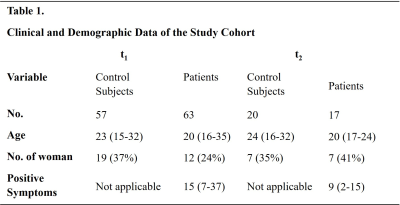 |
Longitudinal study of quantitative susceptibility mapping in patients with the first episode of psychosis
Marisleydis García1,2,3, Néstor Muñoz1,2,3, Carlos Milovic1,2,3, Luz María Alliende4, Bárbara Iruretagoyena4, Alfonzo Gonzalez5, Julio Acosta Carbonero6, Cristián Montalba2,3, Nicolás Crossley2,4, Sergio Uribe2,3, and Cristián Tejos1,2,3
1Departament Electrical Engineering, Pontificia Universidad Catolica de Chile, Santiago de Chile, Chile, 2Biomedical Imaging Center, Pontificia Universidad Catolica de Chile, Santiago de Chile, Chile, 3Millennium Nucleus for Cardiovascular Magnetic Resonance, Pontificia Universidad Catolica de Chile, Santiago de Chile, Chile, 4Neurology Department, School of Medicine, Pontificia Universidad Catolica de Chile, Santiago de Chile, Chile, 5Instituto Psiquiátrico Horwitz, Santiago de Chile, Chile, 6Tenoke Ltd., Cambridge, United Kingdom
Psychosis has been related with dopamine alterations in deep brain nuclei. Neuromelanin is a by-product of the synthesis of dopamine and it is synthesized via iron-dependent oxidation. Thus, susceptibility might give a window to study the progression of dopamine levels at deep brain nuclei of psychotic patients. We studied a cohort of patients with First Episode of Psychosis (FEP) using QSM at two time points and compared them with healthy controls. We found susceptibility changes in seven subcortical areas at FEP onset. We also found susceptibility changes at the left globus pallidus interna after three months of pharmacological treatment.
|

 Back to Program-at-a-Glance
Back to Program-at-a-Glance Watch the Video
Watch the Video Back to Top
Back to Top